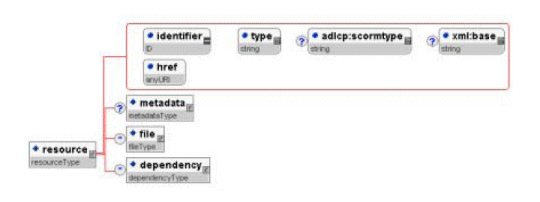I’m going to re-examine the XML format that the SCORM 1.2 CAM specifies for the manifest file. As a reminder, here’s the <resource> tag that I’m trying to understand.
The CAM specification defines the XML format for the <resource> tag like this.

What does this mean? That each <resource> tag contains:
| Attributes | |||
| identifier | A unique reference code for this resource. | Mandatory | One Only |
| type | Identifies the type of resource. SCORM 1.2 only supports one value for this attribute – “webcontent”. | Mandatory | One Only |
| adlcp:scormtype | Identifies the type of SCORM content. SCORM 1.2 only supports two values for this attribute – “sco” or “asset”. | Mandatory | One Only |
| href | A URL pointing to the ‘entry point’ for this resource. | Mandatory | One Only |
| xml:base | A relative path offset for the content file. | Optional | None or One |
| Elements | |||
| metadata | Data describing the resource. | Optional | None or One |
| file | Location (URL) for a file within the package. | Optional | None, One, or Many |
| dependency | Reference to another resource that may contain references to further files and/or resources. | Optional | None, One, or Many |
So, to create a simple example, we might have a structure like this.
When I resolve all of the dependencies, the list of files that I need for the SCO identified as ‘RES01’ is as follows:
myfile01.htm myfile02.gif data/myfile03.txt data/myfile04.txt scripts/myfile05.js scripts/myfile06.js scripts/myfile07.js scripts/myfile08.js
where ‘myfile01.htm’ is the entry point for the SCO. Next time … code to process the dependencies.
